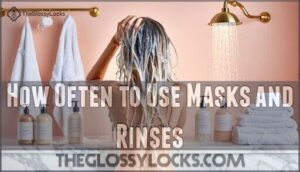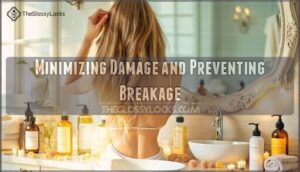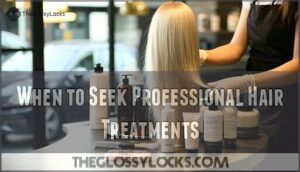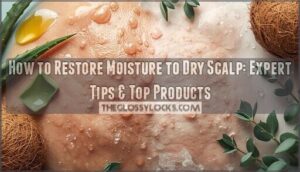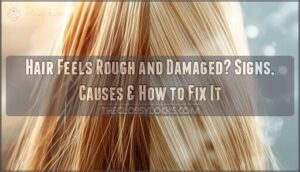This site is supported by our readers. We may earn a commission, at no cost to you, if you purchase through links.
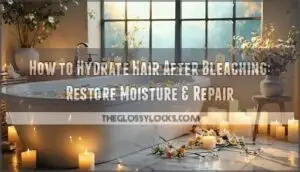
The search for softness becomes a daily ritual: rinsing with cool water, swapping out harsh shampoos, eyeing every conditioner promise with hope and half-dread.
Figuring out how to hydrate hair after bleaching isn’t about quick fixes, but a new rhythm, one that brings patience, the right products, and gentle care into every routine. When you know where and how to start, that bounce and shine can return—sometimes faster than you’d think.
Table Of Contents
- Key Takeaways
- How Should I Hydrate Hair After Bleaching?
- Which Oils Help Restore Bleached Hair?
- DIY Hair Masks and Rinses for Hydration
- Minimizing Damage and Preventing Breakage
- When to Seek Professional Hair Treatments
- Frequently Asked Questions (FAQs)
- How to moisturize your hair after bleaching?
- How to fix bleached hair that feels like straw?
- How long does it take to rehydrate hair after bleaching?
- How to revive dry hair from bleach?
- What are the best products to use for bleached hair?
- How often should I trim my hair after bleaching?
- What can I do to prevent hair breakage after bleaching?
- How can I prevent discoloration of bleached hair in chlorine?
- Can hard water affect bleached hair hydration?
- Is sleeping on silk pillowcases beneficial after bleaching?
- Conclusion
Key Takeaways
- Hydrating bleached hair starts with gentle care routines, like using sulfate-free shampoos, rich conditioners, and weekly deep-conditioning masks.
- Oils such as olive, coconut, argan, and almond help lock in moisture, strengthen hair, and reduce protein loss when used before and after washing.
- Cutting back on washing, avoiding heat and sun exposure, and adopting regular trims are crucial steps to prevent further breakage and dryness.
- Homemade masks with ingredients like avocado and honey, along with rice water rinses, can boost softness and strength while keeping hair manageable.
How Should I Hydrate Hair After Bleaching?
After bleaching, your hair is crying out for moisture, and you need to act fast. The good news is that restoring hydration doesn’t require fancy salon tricks—just the right products and a solid routine.
After bleaching, deeply hydrating your hair quickly with the right products is key to restoring softness and strength
Let’s walk through the essential steps to bring your bleached hair back to life.
Immediate Post-bleach Care Steps
Right after you rinse out the bleach, your hair is at its most vulnerable—the cuticles are wide open, moisture’s been stripped away, and what’s left needs immediate attention to stop further damage in its tracks.
Here’s what you need to do right away for proper hair care after bleaching:
- Cool rinse – Use lukewarm or cool water to help close the cuticle
- Gentle cleansing – Skip harsh shampoos; use sulfate-free formulas only
- Hydration focus – Apply a rich conditioner and leave it on for several minutes
- Protein avoidance – Wait at least a week before protein treatments to prevent brittleness
Choosing Ultra-moisturizing Conditioners
Once the cuticle is closed, your next step is picking the right conditioner. Look for ultramoisturizing conditioners with ingredients like hyaluronic acid, which boosts moisture retention by 93%, or argan oil, proven to cut frizz by 61%.
Hair type matters—fine strands need lightweight formulas, while coarse hair thrives with shea butter-based options. User reviews favor bond-repair conditioners for reducing breakage.
For damaged, color-treated hair, consider conditioners that promote color vibrancy and therapy. Application frequency depends on damage level, but most benefit from weekly deep hair conditioning paired with daily lightweight moisture.
Applying Deep-conditioning Masks Weekly
Your daily conditioner keeps things manageable, but weekly deep-conditioning masks do the real repair work—they sit longer, penetrate deeper, and give bleached strands the intensive moisture they’re craving.
Apply your mask to damp hair, focusing on mid-lengths to ends where damage lives. Leave it on for 20-30 minutes—some treatments work better with a shower cap to trap heat. Rinse thoroughly with cool water to seal the cuticle and lock in that hydration.
Incorporating Leave-in Conditioners
Leave-in conditioners work between washes, giving bleached hair a steady stream of moisture when it needs it most. Whether you spray, cream, or use DIY options, leaveins can tame frizz and shield from daily stress. Look for hydrating formulas rich in oils, proteins, and protective ingredients made for chemically-treated hair.
- Leave-in benefits: smoothness, softness, and lasting hydration
- Application techniques: mist roots lightly, focus on mid-lengths
- Product ingredients: argan, coconut, keratin, or best brands for hair care routines
Adjusting Hair Washing Frequency
If you’ve just bleached your hair, it’s worth rethinking how often you reach for the shampoo bottle. Cutting back aids scalp health and allows natural oils to rebuild moisture.
Stretch your wash schedule: use gentle shampoo alternatives, manage product buildup, and focus on root care. This shift helps retain hydration and keeps bleached hair from tipping into unwanted dryness.
Which Oils Help Restore Bleached Hair?
When your hair feels dry and fragile after bleaching, the right oils can make a noticeable difference. Some work to rebuild strength, while others focus on sealing in moisture.
Let’s look at which oils offer the most benefits for bleached hair.
Benefits of Olive, Coconut, Argan, and Almond Oils
Think of hair oils as a rescue crew for stressed strands. Olive oil improves moisture retention and elasticity; coconut oil penetrates deep, reducing protein loss thanks to its rapid oil absorption rates. Argan oil lends antioxidant protection and boosts shine, while almond oil nourishes the scalp and strengthens.
When combined, these synergistic oil blends help revive dull, brittle hair. Olive oil can also strengthen the hair with regular use.
How to Use Oils Before and After Washing
For an extra boost of softness and protection, adding oils at just the right moments in your wash routine makes all the difference. Massage your chosen hair oils—like coconut or argan—into dry hair before you shampoo for deeper hydration.
After rinsing, apply a smaller amount as a leave-in. The right oil application timing keeps bleached hair smooth and easy to manage.
Sealing Moisture and Preventing Protein Loss
No matter how much you condition, holding onto moisture and protecting your hair’s protein can feel like trying to keep water in a sieve. Oils—used in the right Oil Application Methods—form a barrier that aids Hydration Layering and reinforces Fiber Integrity.
Here are three keys for hair protein loss prevention:
- Cuticle Sealing Techniques for lasting softness
- Managing daily Protein Loss Factors
- Targeted hair strand repair
DIY Oil Blends for Maximum Hydration
Why settle for store-bought when mixing your own blend of nourishing oils can take your hair’s moisture game to the next level? Combine coconut oil and olive oil in a 2:1 ratio for maximum hydration—this oil blend recipe is easy and effective.
Massage into your scalp overnight. This application technique promotes scalp health while locking in moisture for stronger, shinier strands.
DIY Hair Masks and Rinses for Hydration
When your hair is parched after bleach, a little extra care can make all the difference. Simple kitchen ingredients and easy rinses can do wonders for restoring softness and strength.
Here’s what you can try at home to give your hair the hydration it’s looking for.
Avocado, Honey, and Egg White Mask Recipes
Ever wonder how simple kitchen ingredients can breathe new life into dry, fragile hair? DIY hair masks with avocado, honey, and egg white are a revelation for hair hydration.
Avocado’s healthy fats, paired with honey’s moisture-locking properties, help quench parched strands. Customize your recipe, use ripe ingredients, and apply from mid-lengths to ends for best results.
Rice Water Rinse for Strengthening Hair
Just like those nourishing masks in your kitchen, a simple rice water rinse can give your hair an extra boost of strength and shine. The rice water benefits come from inositol, a compound left behind after the fermentation process.
To use, pour cooled rice water through your hair after washing, letting it sit briefly. This gentle hair treatment aids bleached hair and minimizes breakage.
How Often to Use Masks and Rinses
Once you’ve got the hang of rice water rinses and kitchen masks, the next step is figuring out how often your hair needs these treatments to truly bounce back.
For most, a weekly hair mask fits the bill, while rinses can happen two or three times a week. This rinse schedule, plus product rotation and occasional overnight masks, keeps hydrating bleached hair simple.
Store-bought Vs. Homemade Deep Treatments
Some swear by homemade hair masks for control and cost savings, yet store-bought deep treatments use sophisticated ingredients that deliver faster, stronger hair repair—especially for hydrating bleached hair and tackling breakage.
Store-bought options have proven ingredient efficacy, simplified application, better safety measures, and more customization.
Weigh cost comparison, long-term results, and safety concerns before picking the best hair treatment for you.
Minimizing Damage and Preventing Breakage
Once your hair is bleached, the real work is protecting it from new damage. Even small changes in your daily habits can prevent breakage and help hair feel stronger.
Here’s what makes the biggest difference after lightening your hair.
Reducing Heat Styling and Sun Exposure
Think of your hair like your favorite sweater—too much heat or sun, and it starts to lose its shape and softness. To keep strands healthy:
- Limit heat styling to special occasions.
- Choose styling alternatives like air-drying.
- Embrace protective hairstyles to shield ends.
- Always prioritize hydration importance.
- Practice daily UV protection for long-lasting resilience.
Using Sun Protection and Hair Sunscreen
On warm days or anytime you’ll be outside, giving your hair a little extra protection from the sun is just as important as caring for your skin. Reach for a dedicated hair sunscreen, mist, or leave-in with UV defense to guard against UV hair damage. Reapply during long outings. This habit really helps keep bleached hair soft and strong.
| Sunscreen Application Tips | Best Sunscreen Brands | Scalp Sun Protection |
|---|---|---|
| Mist or cream for even use | Sun Bum, Coola, Aveda | Wear hats, part shields |
| Focus on ends and part | Bumble and Bumble, Kerastase | Use direct scalp sprays |
| Reapplication Frequency | Protects all hair textures | SPF powders for roots |
| Use before any sun time | Suits daily styling routines | Essential for thin hair |
Proper Combing and Detangling Techniques
How you use a comb after bleaching can make all the difference between smooth strands and unneeded breakage. Reach for wide-tooth combs and a spritz of detangling spray. Always section hair, start at the ends, and use gentle techniques. This helps protect hair elasticity, avoid split ends, and keeps the hair cuticle smooth.
- Use wide-tooth combs to minimize hair breakage and stress on fragile strands
- Apply detangling sprays before combing for smoother movement and added slip
- Always section hair so you can focus on smaller, manageable pieces
- Start combing from the ends and gently work your way up toward roots
- Embrace gentle techniques—never force the comb through tangles; patience preserves hair elasticity
Trimming Split Ends Regularly
Keeping up with regular trims is one of the simplest ways to help your hair look fresh and keep split ends from traveling up the strand. Aim for a hair cut every 7–9 weeks, using sharp shears for precision.
Smart trimming techniques, like “search and destroy” for dead ends, are key to preventing split-ends and reducing hair breakage.
When to Seek Professional Hair Treatments
Sometimes, at-home care just isn’t enough to get your hair back on track. Certain signs mean it’s time to let a professional take a closer look.
Here’s what you should watch for next.
Signs Your Hair Needs a Stylist’s Help
Sometimes your hair sends up a flare for help, and knowing when to call in a pro can make all the difference. If brushing feels impossible, you notice excessive hair loss, or uneven texture and split ends won’t heal, it’s a sign of severe damage.
Persistent scalp issues or visible hair breakage after color—these call for a hair stylist’s expertise.
In-salon Repair Treatments for Bleached Hair
Ask any colorist—when hair needs a true comeback, professional salon treatments are your strongest safety net. Bond repair services like K18 or Olaplex can undo chemical damage fast.
Moisture infusion, deep hair conditioning treatments, and keratin services leave hair smoother, less frizzy, and strong. Cuticle sealing finishes the job.
Expect treatment costs to range widely, but results often speak for themselves.
Preventing Future Bleach Damage
Nobody wants to undo all their hard work, so let’s talk about how to keep your hair safe from future bleach mishaps. Limit bleaching, use gentle products, and make hydration a daily focus. Regular trims protect against breakage and keep ends healthy.
Prioritize a healthy lifestyle—it truly helps hair porosity, strengthens the hair cuticle, and aids long-term hair damage prevention.
Safe Intervals for Color Touch-ups
Finding the right timing for your next color touch-up is just as important as the care you give between bleach sessions. Check in on regrowth, scalp sensitivity, and strand integrity before booking.
A professional consultation guarantees proper color formulation and keeps hair color maintenance safer, reducing the risk of new hair damage or breakage. Prioritize your hair’s health—never rush.
Frequently Asked Questions (FAQs)
How to moisturize your hair after bleaching?
After a bleach session, your hair feels like straw, aching for moisture. Choose hydration ingredients that suit your porosity, layer hair oils and masks, try overnight treatments, and nurture scalp health—each step brings lost moisture back.
How to fix bleached hair that feels like straw?
Straw-like texture after lightening signals severe hair dryness and breakage.
Consistent protein treatments, moisture-rich conditioners, and scalp health check-ins are essential.
Hydration methods suited for bleached hair, combined with gentle styling and healthy lifestyle factors, speed hair repair.
How long does it take to rehydrate hair after bleaching?
Restoring full hydration in bleached hair usually takes about 6–8 weeks, depending on Damage Severity and your Regimen Impact.
Hair Porosity and Consistent Care with masks or targeted Hair treatment options can speed up the Hair repair process.
How to revive dry hair from bleach?
Too dry after bleach? It’s fixable. Hydrate and balance moisture with weekly hair masks, moisturizing techniques, and gentle products.
Focus on bleach recovery—think oil blends and less frequent washes for true damage control, hair regrowth, and resilience.
What are the best products to use for bleached hair?
For bleached hair, look for Moisturizing Shampoos, Deep Conditioners, Hair Serums, and Repair Creams.
Leave-in Products and rich hair masks, especially those with coconut or olive oil, help keep moisture locked in between washes.
How often should I trim my hair after bleaching?
Don’t let split ends get the upper hand—every 7-9 weeks is the ideal trimming frequency.
Regular trims help post-bleach maintenance, prevent hair breakage, and keep your hair health in check, supporting smooth regrowth and moisture retention.
What can I do to prevent hair breakage after bleaching?
Preventing hair breakage starts with gentle combing and smart hair moisturizing techniques.
Integrate hair supplements if needed, focus on hydrating masks, avoid heat, trim split ends regularly, and consider professional damage control for complete hair repair.
How can I prevent discoloration of bleached hair in chlorine?
Jumping from the 1990s into today, pool care matters more than ever.
To prevent chlorine damage and avoid discoloration, protect bleached hair with a swim cap, rinse immediately afterward, and add a weekly color protection mask to your hair care routine.
Can hard water affect bleached hair hydration?
Hard water can lower hydration levels in bleached hair, leaving strands rough or dull. Mineral buildup disrupts pH balance and blocks hair moisture, making your hair care routine less effective for hydrating and repairing bleached hair. Water quality matters.
Is sleeping on silk pillowcases beneficial after bleaching?
Swapping to silk pillowcases in your nighttime routine cushions hair from friction and breakage. The fabric’s smooth surface lets bleached hair glide, locking in hair moisture and supporting hair hydration for softer, healthier strands.
Silk pillow benefits are real.
Conclusion
Worried it’s too late for your hair to bounce back? Even after harsh bleaching, real change starts with a shift in daily habits.
Hydration is more than a treatment—it’s a way of caring, patiently, with products that work for your needs. With each nourishing step, you renew softness and shine, showing that bleached hair can recover and thrive.
Learning how to hydrate hair after bleaching isn’t about flawlessness; it’s about honoring your hair’s resilience each day.
- https://us.davines.com/blogs/news/how-to-rehydrate-your-hair-after-bleaching
- https://hairfolli.com/blogs/news/understanding-the-effects-of-bleaching-hair-a-guide-to-minimizing-damage
- https://www.sittingprettyhalohair.com/blogs/news/how-to-hydrate-hair-after-bleaching
- https://pmc.ncbi.nlm.nih.gov/articles/PMC11652465/
- https://www.healthline.com/health/beauty-skin-care/how-to-hydrate-hair-after-bleaching




